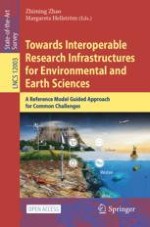1 Data-Centric Science in Environmental and Earth Sciences
1.1 Relevance to the Big Questions of Science and Society
1.2 Supporting Sustainable Development with Data
1.3 The Role of Research Infrastructures
2 The ENVRIplus Objectives
3 Example Science Cases Related to Environmental Research Infrastructures
3.1 Climate Change and Atmospheric Composition Research (ICOS, ACTRIS and IAGOS)
3.2 Mitigating the Societal and Economic Impacts of Future Volcanic Eruptions and the Role of the European Plate Observing System (EPOS)
3.3 The Importance of Data Management to Solve Societal and Scientific Questions for the Oceans (SeaDataNet)
-
Scientific research to gain knowledge and insight
-
Monitoring and assessment (water quality, climate status, stock)
-
Coastal Zone management
-
Modelling (including hindcast, now-cast, forecast)
-
Dimensioning and supporting operations and activities at sea (shipping, offshore industry, and dredging industry)
-
Implementation and execution of marine conventions for the protection of the seas, including aligning with international legislation such as the European Marine Strategy Framework Directive (MSFD).
4 The ENVRIplus Data to Science Theme
-
optimise data processing and to develop common models, rules and guidelines for research data workflow documentation;
-
facilitate data discovery and use, and to provide integrated end-user information technology to access heterogeneous data sources;
-
make data citable by developing existing approaches with practical examples, exchange of expertise, and agreements with publishers;
-
facilitate the discovery of software services and their composition;
-
characterise users and build a community evolving from current RI communities;
-
characterise ICT resources (including sensors and detectors) to allow virtualisation of the environment (for instance onto Grid- or Cloud-based platforms) such that data and information management and analysis is optimised in use of resources and energy usage;
-
facilitate the connection of users, composed software services, appropriate data and necessary resources in order to meet end-user requirements.
5 The FAIR Principles as Guidelines for Data Management
-
F1. (meta)data are assigned a globally unique and eternally persistent identifier.
-
F2. data are described with rich metadata.
-
F3. (meta)data are registered or indexed in a searchable resource.
-
F4. metadata specify the data identifier.
-
A1 (meta)data are retrievable by their identifier using a standardised communications protocol.
-
A1.1 the protocol is open, free, and universally implementable.
-
A1.2 the protocol allows for an authentication and authorization procedure, where necessary.
-
-
A2 metadata are accessible, even when the data are no longer available.
-
I1. (meta)data use a formal, accessible, shared, and broadly applicable language for knowledge representation.
-
I2. (meta)data use vocabularies that follow FAIR principles.
-
I3. (meta)data include qualified references to other (meta)data.
-
R1. meta(data) have a plurality of accurate and relevant attributes.
-
R1.1. (meta)data are released with a clear and accessible data usage license.
-
R1.2. (meta)data are associated with their provenance.
-
R1.3. (meta)data meet domain-relevant community standards.
-
